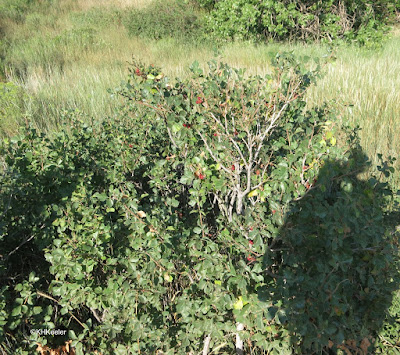The USDA calls it skunkbush sumac. Other sources call it three-leaf sumac, skunkbush, lemonberry sumac and in the older literature, squawbush. It is Rhus trilobata in the sumac and poison ivy family, Anacardiaceae.
The name skunkbush comes from the odor of the shrub, which many people find unpleasant and I have never noticed.
The plant is easily recognized by the three-lobed leaves. It doesn't look much like the sumacs of the eastern U.S., even though it is in the same genus.
The fruit is edible and nutritious. Remains of the berries have been found in Ancient Puebloan sites in New Mexico, Colorado, Utah and Arizona, and were very numerous in Antelope House at Canyon de Chelley, dated to 1200 CE. Elsewhere in the west the archaeological record is not as good, but certainly the plant was used all across western North America. Modern tribes from the Apache and Hopi in the southern United States to the Gosiute in Utah and tribes in Montana all reported valuing it as food.
Harrington, foraging in the Rocky Mountains of Colorado, wrote that although they could be gathered and eaten all winter, the flavor of three-leaf sumac fruits was best in the fall. One common use is to make a drink by steeping the fuzzy red berries: it tastes like lemonade. Enthusiasm varies among foragers, however. Elpel and Reed considered three-leaf sumac fruits "not really a food" just a berry to snack upon. Seebeck recommended the juice in any recipe that calls for lemon juice. Morgan mixed the fruits with cornmeal to make cakes, added them to tapioca pudding or made jam.
It is important to note that although three-leaf sumac fruit is edible, many of its relatives cause serious allergic reactions in people, poison ivy being the most widely known to Americans. People prone to allergies or who react strongly to poison ivy should be wary of three-leaf sumac. (And, don't touch it if you can't tell the difference between it and poison oak.)
It had many medical uses among Native American tribes, from creating a poultice for cuts and blisters to eating the berries to treat a cold. (link, link)
Native Americans especially valued three-leaf sumac wood for weaving. It is both strong and flexible and was woven, using twigs or split branches, into baskets, cradles, sunshades, hats and other useful items. Different tribes, using different processes, dyed with three-leaf sumac, using it as a mordant because of the high tannin content of the leaves, but also to get black, blue, red-brown and pink-tan dyes.
When you are hiking past thickets in the West, watch for three-leaf sumac and imagine yourself not as just a passerby but as a member of a local tribe, noting the location of this pretty shrub as a source of food, medicine and weaving materials.
Comments and corrections welcome.
Sources
Dunmire, W.W. and G. D. Tierney. Wild plants and native peoples of the Four Corners. Museum of New Mexico Press, Santa Fe. 1997.
Elepl, T. J. and K. Reed. 2014. Foraging the mountain west. Hops Press, LLC., Pony Mountana.
Harrington, H.D. 1967. Edible native plants of the Rocky Mountains. University of New Mexico Press, Albuquerque.
Moerman, D. E. 1998. Native American ethnobotany. Timber Press, Portland, Oregon.
Morgan, L. B. 2013. Foraging the Rocky Mountains. Falcon Guides, Guilford, Connecticut.
Seebeck, C.B. 1998. Best-tasting wild plants of Colorado and the Rockies. Westcliffe Publishers, Englewood, Colorado.
Kathy Keeler, A Wandering Botanist
More at awanderingbotanist.com





No comments:
Post a Comment